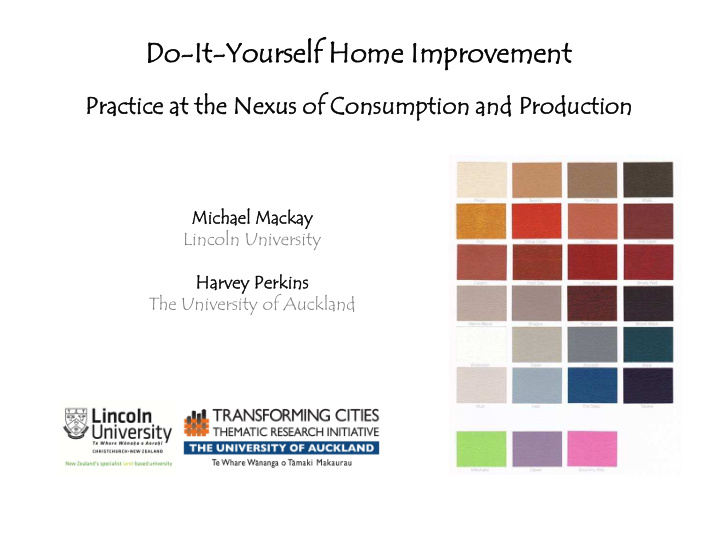



Do Do-It It-Yo Yourse self f Home Improvem emen ent Practice Pr e at at th the Nexus us of Consumpti tion an and P Produc ucti tion Micha hael el Mackay ay Lincoln University Harve arvey P Perk rkins The University of Auckland
Thoug ughts ts abo about c ut consum umption an and p produc ucti tion Accounts of liquid modernity (e.g., Bauman) and the rise of • consumer society provide insight into the great significance of consumption and shopping in everyday life. Such accounts, however, do very little to help us understand • what people actually do with the commodities they buy. Barnett et al. (2011) suggest that while co consu sumpt ption (as • shopping) is important, we should not lose sight of what goes on past the shop counter. These purchases make possible an important cluster of • prod oductive e human actions involving practical skills and abilities, innovative thinking, creativity, emotions, conversations and ‘teamwork’. In this paper, using a New Zealand study of DIY home • improvement, we want to illustrate how in many everyday practices, consumption and production co combine in what Ritzer (2009) terms prosumption.
What is DI Wh is DIY? DIY stands for ‘do-it-yourself’ home improvement • It occurs when homeowners decorate, alter, build, • maintain or repair any part of their home themselves. DIY projects: simple, one-off repairs through to major • structural alterations requiring technical information, Mid 1950s - USA building consents, design advice and/or a large investment by homeowners in tools and materials. It is a global phenomenon: big in New Zealand, but also • the USA, Canada, Australia and Europe, and emerging in Japan and China. Gendered in interesting ways • 2000’s – NZ/OZ
DIY: IY: Disp Disparate in e international literat atur ure Economics cs: : Economic determinants of the decision to do • DIY Hi Hist story: Historical accounts of DIY movement in • different contexts (usually with a strong gender perspective); DIY and “suburban husbanding” (Gelber, 1999) Property/Ho Pr Housi sing St Studie ies: Policy work: Home • improvement loans and the state of the housing stock Retail St l Studies/Marketin ing: : Purchasing decisions, consumer • behaviour and market research, particularly tools and equipment So Socia ial Sc l Scie ience: The division of domestic labour, • homemaking, gender identities, material culture and consumption, leisure and the meaning of house and home: but interestingly little reflection on questions of the links between consumption and producti tion.
DI DIY in in New ew Zea Zeala land A well-established set of cultural practices. • Often linked to NZ’s high level of home • ownership and domestic property as investment. Became widespread in the post war era • (associated with suburbanisation). Today the culture is reinforced by • advertisers e.g., “DIY: its in our DNA”. NZ$1 billion spent per year on tools and • materials. Big box retailers now dominate the DIY • shopping landscape. (Bunnings, for example, employing over 3000 staff)
Our Our s stud tudy of of D DIY h IY home ome improv oveme ment NZ homeowner interviews (n=27) with house/shed tour, observations & participation • Key informant interviews with retail industry participants (n=15) • Analysis of ads, media and DIY manuals & mags • DIY from the perspective of both day-to-day practice and globalised political economy •
DIY a as consumpt mption on a and prod oduct ction on Consumpt mption on Consumption as shopping is an inescapable aspect of DIY (e.g., you need eed drills, nails, • wallpaper, lifestyle magazines etc.). Tools: To s: purchased, inherited, borrowed, gifted: Respondents owned or aspired to own a • variety of DIY tools – some had very large collections. Materials ls: : extensive range of materials purchased ranging from “raw’ product (timber) • through to those packaged especially for DIY enthusiasts; and sometimes sourced by foraging in second hand outlets. Ide deas: s: drawn from internet, magazines, reality TV, advertisements: these sources created a • discourse of style and appropriateness and the things needed to achieve them.
Produ ductio ion While our research participants certainly engaged in the world as consumers, they also took • the role and identity of ‘producers’ which involved the following: Helping hands: enrolling family and friends not resident at the house – reciprocity, inter- • generational family support and cohesion Informal professional help: getting family or friends with building skills to help – “mates • rates” The “working bee”: a one-off social event designed to entertain and get things done • DIY/professional mix: various combinations of contribution – sometimes to meet • regulatory requirements
Wh What’s Pr s Produ duced ed? Inte terior de deco coration – the most frequently conducted DIY activity: impressing visitors and • keeping up with fashion Repair ir and d maintenance – fixing not adding • Built lt f form – major projects such as bathroom or kitchen conversions, room re- • configuration Garde dens a s and d landsca dscape pes • Participants are producing their social and materials worlds, while simultaneously ‘building’ • ties . and maintaining their identi titi
Conclu lusio ions The product of DIY practice is the DIYed • home: a socially and physically constructed place which is personalised, adapted, displayed and to be enjoyed. While shopping is a crucially important part • of DIY, it is much more than this. Each DIY project is an act of prosumption at • the centre of an extensive social world (Becker, 1982) comprising: householders, tools, materials, ideas, families, friends, DIY stores and their employees, popular and technical media, advertisements etc.
Recommend
More recommend